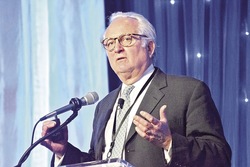
Philippe de Lapérouse, managing director at High Quest Partners, talks about investing in agriculture. (Photo: AgriNews photo/Erica Quinlan)
Ag draws investors’ attention
by Erica Quinlan
INDIANAPOLIS — The agriculture industry is piquing the interest of investors around the world, according to an investment strategy expert.
Philippe de Lapérouse, managing director at High Quest Partners, was a keynote speaker at the Indiana Agbiosciences Innovation Summit.
“Agriculture is estimated to be the third-largest market in the world,” he said. “When you combine food and beverage with production agriculture and the various adjacent industries in the supply chain, it accounts for approximately $7 trillion in revenue on a global basis.”
Adjacent industries include services, capital risk, insurance, inputs and processors, making the industry complex and diverse.
“Agriculture has been misunderstood by the general public throughout the last century and misunderstood by the investing community,” Lapérouse said. “One of the things we run across is that, when investors come into the sector for the first time, they presume it’s easy.
“It’s a very complex supply and value chain, which requires a lot of experience. You have to understand how each of the participants in the value chain relate to each other. That will determine when it’s a good time to allocate investments and who to invest with along that value chain.”
Institutional investors are focused on inputs, processing and transportation.
Lapérouse has observed evolving trends in agriculture, including a shift to non-traditional crops.
“There’s increasing interest beyond row crops,” he said. “There’s interest in nut trees, fruits and vegetables, etc.
“Sustainability and consumer quality issues are becoming paramount and are drivers for investment in the sector.”
Trends In Agricultural Investing
-Frontier markets in Africa continue to attract capital.
-Increasing tendency among large institutions, such as pension funds, to bring sectorial expertise in-house to pursue direct investments as opposed to investing in funds.
-Permanent crops and situations involving mix of real assets with exposure to operating risks attracting investors seeking higher returns.
-Sustainability and consumer quality concerns becoming drivers for the adoption of new technologies and business models.
-Distressed assets in Brazil present unique opportunities.
“One of the questions we’ve had is ‘Is agriculture becoming its own separate asset class?’” Lapérouse said. “The way markets look at energy, real estate, chemicals, etc. The consensus is yes indeed, it is becoming its own asset class.
“We estimate that, on a global basis, the assets under management invested in farmland represent $35 (billion) to $45 billion.”
He shared four reasons why agriculture is attracting investors:
1. Supply and demand imbalances. Demand for land and soft commodities is being driven by several strong macro trends.
2. Inflation hedge and wealth preservation.
3. Low correlation to other asset classes.
4. Under-owned by institutional investors.
“There are many ways to invest in most stages of the agricultural value chain via equities, corporate bonds, futures options, etc.,” he said. “Possible areas include inputs, processing, consumer products and retail.”













